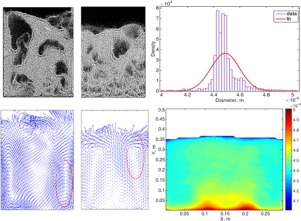Particuology ( IF 4.1 ) Pub Date : 2019-07-02 , DOI: 10.1016/j.partic.2019.04.001 Abolhasan Hashemisohi , Lijun Wang , Abolghasem Shahbazi , Hossein Amini

|
A dense discrete phase model combined with the kinetic theory of granular flows was used to study the bubbling characteristics and segregation of poly-dispersed particle mixtures in a thin fluidized bed. Our simulations showed that in using the hybrid Eulerian–Lagrangian method, the common use of one computational cell in the thickness direction of the thin bed does not predict wall friction correctly. Instead, a three-cell discretization of the thickness direction does predict the wall friction well but six cells were needed to prevent overprediction of the bed expansion. The change in specularity factor (SF) of the model not only affected the predictions of the velocity of particles, but also had a considerable impact on their flow pattern. A decrease in SF, which decreases wall friction, showed an over-prediction in the size of bubbles, particle velocities, and void fraction of the bed, and led to a shift in the circulation center toward the bottom of the bed. The segregation of the Geldart B particles was studied in the narrow range from 400 to 600 μm with a standard deviation less than 10% of the average diameter. Simulations showed that large particles accumulated close to the distributor at the bottom of the bed and the center of the bed, but small particles moved towards the wall and top surface. The decrease in the mean particle size and spread in shape of the distribution improves mixing by up to 30% at a superficial gas velocity of around 2.5 times the minimum fluidization velocity. Log-normal mixtures with a small proportion of large particles had the most uniform distribution with a thin layer of jetsam forming at the bottom of the bed. Finally, experimental verification of the segregation and mixing of polydisperse particles with narrow size distribution is suggested.
中文翻译:

使用三维密集离散相模型对各种粒度分布的薄鼓泡流化床流体力学进行数值分析和实验验证
利用稠密离散相模型结合颗粒流动力学理论研究了薄流化床中多分散颗粒混合物的起泡特性和偏析。我们的模拟结果表明,在使用混合欧拉-拉格朗日方法时,通常在薄床厚度方向上使用一个计算单元无法正确预测壁摩擦力。取而代之的是,厚度方向的三单元离散化确实可以很好地预测壁摩擦,但是需要六个单元来防止床层膨胀的过高预测。模型的镜面反射率因子(SF)的变化不仅影响粒子速度的预测,而且对粒子的流态有很大影响。SF的减少会减少壁摩擦,这表明气泡尺寸过高,颗粒的速度和床的空隙率,导致循环中心向床的底部移动。在400至600μm的窄范围内研究了Geldart B颗粒的偏析,其标准偏差小于平均直径的10%。模拟表明,大颗粒聚集在靠近床底部和床中心的分配器附近,但小颗粒向壁和顶表面移动。在大约最小流化速度的2.5倍的表观气体速度下,平均粒径的减小和分布形状的分布将混合提高了30%。具有少量大颗粒的对数正态混合物具有最均匀的分布,并且在床层底部形成了一层喷射颗粒。最后,











































 京公网安备 11010802027423号
京公网安备 11010802027423号